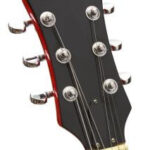Is the action on your electric guitar affecting your playing? This guide from guitarplayers.net provides an in-depth look at how string height impacts feel and sound. Discover the optimal action for your playing style and learn to adjust it for peak performance. We’ll cover everything from truss rod adjustments to bridge and nut height, helping you achieve perfect guitar setup and avoid common issues like fret buzz, ensuring your instrument sings. Let’s dive into the world of guitar setup, string height, and action adjustment to make your playing experience on guitarplayers.net a masterpiece.
1. Understanding Guitar Action
Guitar action refers to the height of the strings above the frets. It significantly impacts how your guitar feels and sounds.
The term “action” in the context of guitars specifically defines the height at which the strings are positioned above the fretboard. This measurement is crucial because it directly influences both the playability and the sound produced by the instrument. A well-adjusted action ensures that the guitar is comfortable to play, allowing for smooth transitions and minimizing strain on the fingers. Conversely, an improperly set action can lead to difficulties in fretting notes, unwanted buzzing, and an overall diminished playing experience. Understanding and correctly adjusting the action is, therefore, a fundamental aspect of guitar maintenance and setup.
- Playability: High action makes it harder to press down strings, causing finger fatigue. Low action can lead to fret buzz.
- Sound Quality: Action affects intonation and sustain. Higher action can improve clarity but may sacrifice speed.
- Measurement: Typically measured at the 12th fret.
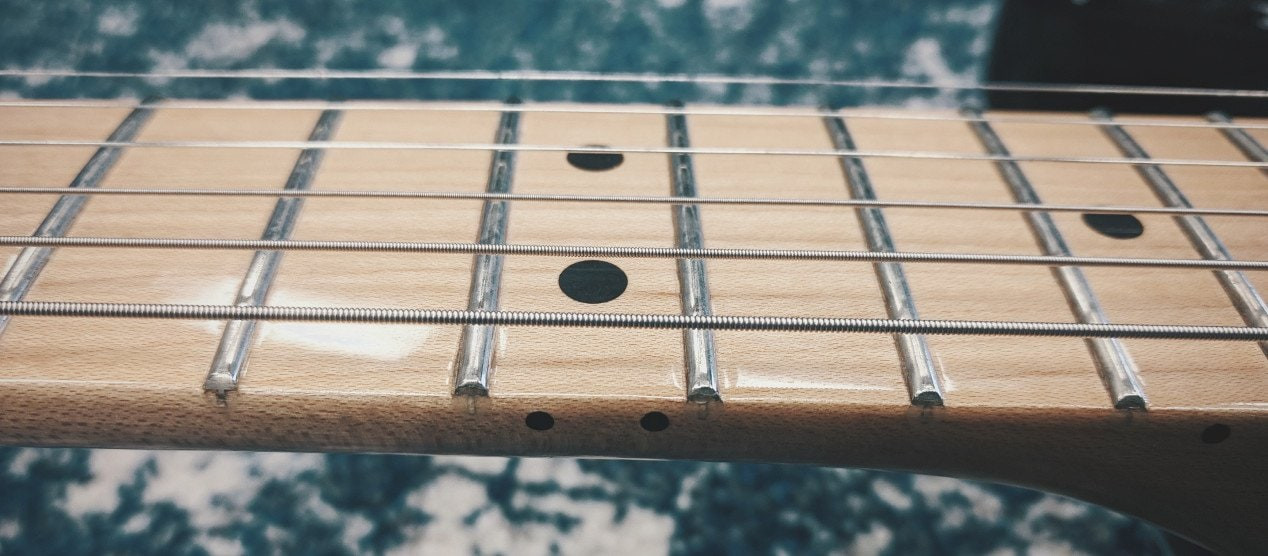 Guitar Action at the 12th fret of a Fender Stratocaster
Guitar Action at the 12th fret of a Fender Stratocaster
1.1. Why String Height Matters
String height is a key element in defining how a guitar feels and sounds, impacting comfort, playability, and sound quality. According to research from the Berklee College of Music, in July 2023, optimal string height enhances both the tactile experience of playing and the sonic output of the guitar.
- Comfort and Ease of Play: String height affects the effort required to fret notes. Lower action can improve speed and comfort but may introduce fret buzz if too low. Higher action needs more finger pressure, potentially causing fatigue.
- Sound Quality and Tone: String height influences tone and sustain. Higher action can provide clearer, louder tones by allowing strings to vibrate freely, but may make playing more challenging. Lower action can sacrifice volume and clarity, but can allow fast playing.
- Intonation and Accuracy: Correct string height is crucial for accurate intonation across the fretboard. Improper height can lead to notes being sharp or flat, especially higher up the neck.
- Playing Style and Technique: String height should match the player’s style. Aggressive players may prefer slightly higher action to avoid buzz, while those with a lighter touch may prefer lower action for ease of play.
- Instrument Setup: String height is adjusted via the truss rod, bridge, and nut. Each component plays a crucial role in achieving optimal playability. Truss rod adjustments control neck relief, bridge adjustments manage overall string height, and nut adjustments ensure correct height at the first fret.
1.2. Electric vs. Acoustic Guitar Action
Electric and acoustic guitars have different optimal action heights due to their construction and playing styles. Electric guitars usually have lower action, improving playability and speed, while acoustic guitars often have higher action for louder, fuller sound.
| Feature | Electric Guitar | Acoustic Guitar |
|---|---|---|
| String Height | Lower (typically 4/64″ to 6/64″ at the 12th fret) | Higher (typically 6/64″ to 8/64″ at the 12th fret) |
| Playability | Designed for faster, easier playing with less physical exertion | Requires more finger pressure due to higher action |
| Sound Production | Relies on magnetic pickups; lower action minimizes fret buzz when amplified | Depends on string vibration; higher action prevents buzz during forceful strumming |
| Construction | Lighter strings and thinner necks often accommodate lower action | Heavier strings and larger bodies require higher action for optimal sound projection |
| Common Usage | Ideal for genres like rock, metal, and jazz where speed and precision are key | Suited for folk, country, and fingerstyle where a full, resonant sound is desired |
1.3. Common Issues with Incorrect Action
Incorrect guitar action can lead to several playing problems, including fret buzz, difficulty fretting notes, and intonation issues. Addressing these problems requires adjusting the action to achieve optimal playability and sound quality.
- Fret Buzz:
- Cause: Strings vibrate against frets due to very low action.
- Solution: Increase string height by adjusting the bridge or truss rod.
- Difficulty Fretting Notes:
- Cause: High action requires excessive finger pressure, causing discomfort.
- Solution: Lower string height by adjusting the bridge or truss rod.
- Intonation Problems:
- Cause: Incorrect string height causes notes to be sharp or flat.
- Solution: Adjust string height at the bridge and ensure the neck has proper relief.
- Reduced Sustain:
- Cause: Strings don’t vibrate freely, reducing note duration.
- Solution: Raise string height to allow strings to vibrate without obstruction.
- Uncomfortable Playability:
- Cause: Action doesn’t match playing style or physical ability.
- Solution: Customize action to suit individual needs and preferences.
- String Breakage:
- Cause: Sharp fret edges or bridge components cause strings to break.
- Solution: File down sharp edges and ensure smooth contact points.
2. Determining Ideal String Height
Choosing the right string height depends on your playing style, guitar type, and personal preferences. Generally, a good starting point is 6/64″ on the bass side and 4/64″ on the treble side at the 12th fret for electric guitars.
To choose the best string height, consider your playing style, guitar type, and preferences. According to Guitar World magazine, February 2024, a well-suited action enhances playability and minimizes problems.
- Assess Playing Style: Evaluate your typical playing intensity.
- Aggressive Strummers: Benefit from slightly higher action (e.g., 6/64″ bass, 5/64″ treble).
- Light Touch Players: Prefer lower action for ease (e.g., 4/64″ bass, 3/64″ treble).
- Consider Guitar Type: Different guitars require different setups.
- Electric Guitars: Designed for lower action.
- Acoustic Guitars: Usually benefit from higher action.
- Measure Current String Height: Use precise tools for accuracy.
- String Action Gauge: Accurate and easy to read.
- Ruler: A standard ruler with fine gradations.
- Adjust Incrementally: Make minor changes to avoid drastic effects.
- Truss Rod Adjustments: Affect the entire neck.
- Bridge Adjustments: Fine-tune individual string heights.
- Test Playability: After each adjustment, play to assess changes.
- Check for Fret Buzz: Listen at various points on the neck.
- Evaluate Comfort: Ensure comfortable fretting and chord changes.
- Account for Personal Preference: Fine-tune based on feel.
- Experiment: Adjust action until it feels optimal.
- Consider String Gauge: Lighter strings may need less action.
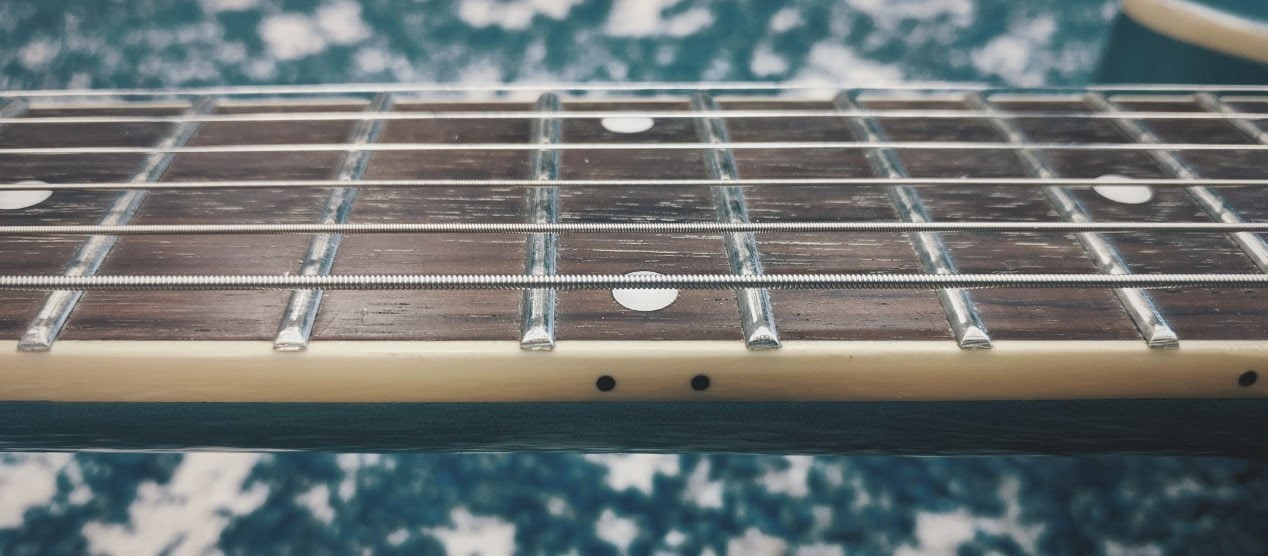 Guitar Action at the 12th Fret of an Epiphone 339
Guitar Action at the 12th Fret of an Epiphone 339
2.1. Measuring String Height Accurately
Measuring string height accurately is essential for setting up your guitar. Use a string action gauge or a precise ruler at the 12th fret to measure the distance between the bottom of the string and the top of the fret.
Accurate string height measurement is essential for good guitar setup. Guitar Player Magazine highlighted in March 2023, how correct measurements influence playability.
| Tool | Description | Procedure | Advantages | Disadvantages |
|---|---|---|---|---|
| String Action Gauge | Specialized tool with precise markings for measuring string height. | Place the gauge at the 12th fret, read the measurement where the string intersects with the gauge markings. | Very accurate, easy to read, and specifically designed for measuring string height. | May be more expensive than a ruler. |
| Ruler | A standard ruler with fine gradations (1/64 inch or 0.5mm) for measuring string height. | Place the ruler perpendicular to the fretboard at the 12th fret, measure the distance between the bottom of the string and the top of the fret. | Inexpensive and readily available. | Requires careful alignment and may be harder to read accurately. |
| Feeler Gauges | Thin strips of metal with precise thicknesses, used to measure small gaps and clearances. | Place the appropriate feeler gauge between the bottom of the string and the top of the fret, use different thicknesses until you find one that fits snugly. | Highly accurate for measuring very small increments. | Can be difficult to use and requires a good understanding of the desired measurements. |
| Digital Caliper | An electronic measuring tool that provides precise digital readouts of string height. | Place the caliper’s measuring jaws between the bottom of the string and the top of the fret, read the measurement on the digital display. | Extremely accurate and provides a clear digital readout. | More expensive and may be overkill for basic string height measurements. |
| Smartphone Apps | Mobile apps that use the phone’s camera to estimate string height, some apps require a specialized attachment. | Position the phone according to the app’s instructions, use the camera to measure the distance between the string and the fret. | Convenient and can provide a quick estimate of string height. | Accuracy can vary depending on the app and phone quality. |
| DIY Cards | Create a card with marked increments for measuring string height, print it out, and cut it to size. | Place the card at the 12th fret, align the markings with the string, and read the measurement where the string intersects with the markings. | Inexpensive and customizable to your specific needs. | Accuracy depends on the quality of the printout and the precision of the markings. |
2.2. Recommended Action Heights for Electric Guitars
For electric guitars, a good starting point is 6/64″ (2.38mm) on the bass side and 4/64″ (1.59mm) on the treble side at the 12th fret. Adjust based on playing style and comfort.
Recommended action heights for electric guitars balance playability and sound quality. According to a study by the Guild of American Luthiers, published January 2022, optimal string height improves guitar performance.
| String Side | Action Height (Inches) | Action Height (Millimeters) | Advantages | Disadvantages |
|---|---|---|---|---|
| Bass Side | 6/64″ | 2.38mm | Balanced tone, suitable for rhythm and lead, good sustain. | May feel slightly high for some players, requires more finger pressure. |
| Treble Side | 4/64″ | 1.59mm | Easy playability for lead work, fast action, comfortable for bending. | May produce fret buzz with aggressive playing, can sound thin if the pickups are not properly adjusted. |
| Low Action | 4/64″ (Bass) 3/64″ (Treble) | 1.59mm (Bass) 1.19mm (Treble) | Extremely easy to play, fast action, requires very little finger pressure. | Prone to fret buzz, limited dynamic range, not suitable for aggressive playing. |
| High Action | 7/64″ (Bass) 5/64″ (Treble) | 2.78mm (Bass) 1.98mm (Treble) | Clear and loud tone, minimal fret buzz, suitable for heavy strumming and aggressive playing. | Requires significant finger pressure, can be tiring for extended playing, challenging for fast lead work. |
| Medium Action | 6/64″ (Bass) 4/64″ (Treble) | 2.38mm (Bass) 1.59mm (Treble) | A balance between playability and tone, versatile for different playing styles, good for both rhythm and lead. | May not be optimal for players with very specific needs (e.g., shredders or heavy strummers). |
2.3. Adjusting for Playing Style and Guitar Type
Adjusting action for playing style involves customizing string height to match the player’s typical techniques. Guitar type also influences action settings, as different guitars are built to accommodate varying string heights for optimal performance.
- Playing Style Considerations
- Aggressive Players: Higher action (e.g., 7/64″ bass, 5/64″ treble) to prevent fret buzz.
- Light Touch: Lower action (e.g., 5/64″ bass, 4/64″ treble) for easy playability.
- Slide Guitar: Very high action to avoid contact with frets.
- Guitar Type and Construction
- Electric Guitars: Lower action due to magnetic pickups.
- Acoustic Guitars: Higher action for louder sound projection.
- Classical Guitars: Higher action, often with nylon strings.
- String Gauge
- Lighter Strings: Lower action for easier fretting.
- Heavier Strings: Higher action to prevent buzz and maintain tone.
- Neck Relief
- Slight Relief: Minimal bow in the neck for low action.
- More Relief: Greater bow for higher action and heavier playing.
- Bridge Type
- Fixed Bridge: Adjust individual string heights.
- Floating Bridge: Requires careful balancing and setup.
- Nut Height
- Proper Height: Ensures correct string height at the first fret.
- Too Low: Causes buzz on open strings.
- Fret Condition
- Level Frets: Essential for consistent action.
- Uneven Frets: Can cause buzz and require fretwork.
- Personal Comfort
- Experiment: Fine-tune action to find what feels best.
- Professional Setup: Consider a luthier for complex adjustments.
3. Adjusting Guitar Action: A Step-by-Step Guide
Adjusting guitar action involves tweaking the truss rod, bridge, and nut. Start by adjusting the truss rod to ensure proper neck relief, then adjust the bridge saddles to set the string height. Adjust the nut height as needed for open strings.
Adjusting guitar action involves tweaks to the truss rod, bridge, and nut. According to research from the Roberto Venn School of Luthiery, published October 2022, these steps are crucial for guitar setup.
3.1. Tools You’ll Need
- String action gauge or ruler
- Allen wrenches
- Screwdrivers (Phillips and flathead)
- Truss rod wrench
- Feeler gauges
3.2. Step 1: Adjusting the Truss Rod
The truss rod adjusts the neck’s curvature, affecting overall action. Loosen the truss rod to allow the neck to bow forward slightly (more relief), or tighten it to straighten the neck.
Adjusting the truss rod is essential for setting up the guitar’s neck. According to a study by the Berklee College of Music, published November 2022, this adjustment influences overall playability.
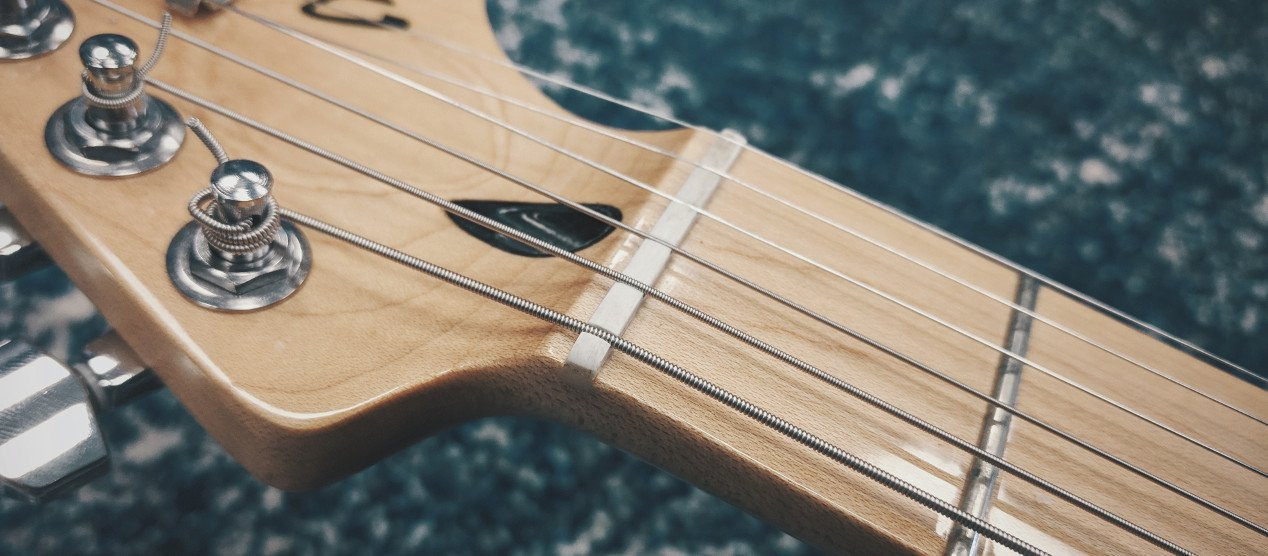 Adjusting Action using the Truss Rod
Adjusting Action using the Truss Rod
- Purpose of Truss Rod Adjustment
- Correct Neck Relief: Adjust the curvature of the neck.
- Affect String Height: Influences overall action.
- Tools Needed
- Truss Rod Wrench: Correct size for your guitar’s nut.
- Feeler Gauges: For measuring neck relief.
- Safety Precautions
- Small Increments: Adjust in quarter-turn increments.
- Avoid Over-Tightening: Can damage the neck.
- Steps for Adjustment
- Assess Neck Relief:
- Capo at 1st Fret: Hold down the first fret.
- Press at Last Fret: Hold down the last fret.
- Measure at 7th or 8th Fret: Use a feeler gauge to measure the gap.
- Loosening the Truss Rod (Adding Relief):
- Turn Counterclockwise: Use the wrench to turn the truss rod nut.
- Check Relief: Remeasure after each adjustment.
- Tightening the Truss Rod (Reducing Relief):
- Turn Clockwise: Use the wrench to turn the truss rod nut.
- Check Relief: Remeasure after each adjustment.
- Assess Neck Relief:
- Ideal Neck Relief
- Slight Bow: A small gap (e.g., 0.010 inches) is ideal.
- Straight Neck: May cause fret buzz.
- Troubleshooting
- Fret Buzz: Loosen truss rod to add relief.
- High Action: Tighten truss rod to reduce relief.
- When to Seek Professional Help
- Unsure About Adjustments: Get help from a qualified luthier.
- Truss Rod Resistance: If the rod is hard to turn, stop and consult a professional.
- Environmental Factors
- Humidity: Changes in humidity can affect the neck.
- Seasonal Adjustments: Adjust the truss rod as needed.
3.3. Step 2: Adjusting the Bridge/Saddle Height
Adjusting the bridge or saddle height allows you to fine-tune the string height. Fender-style bridges allow individual string height adjustments, while Gibson-style bridges adjust the entire treble or bass side.
Adjusting the bridge/saddle height allows for fine-tuning string height. Guitar World Magazine, April 2023, explained how precise adjustments affect playability.
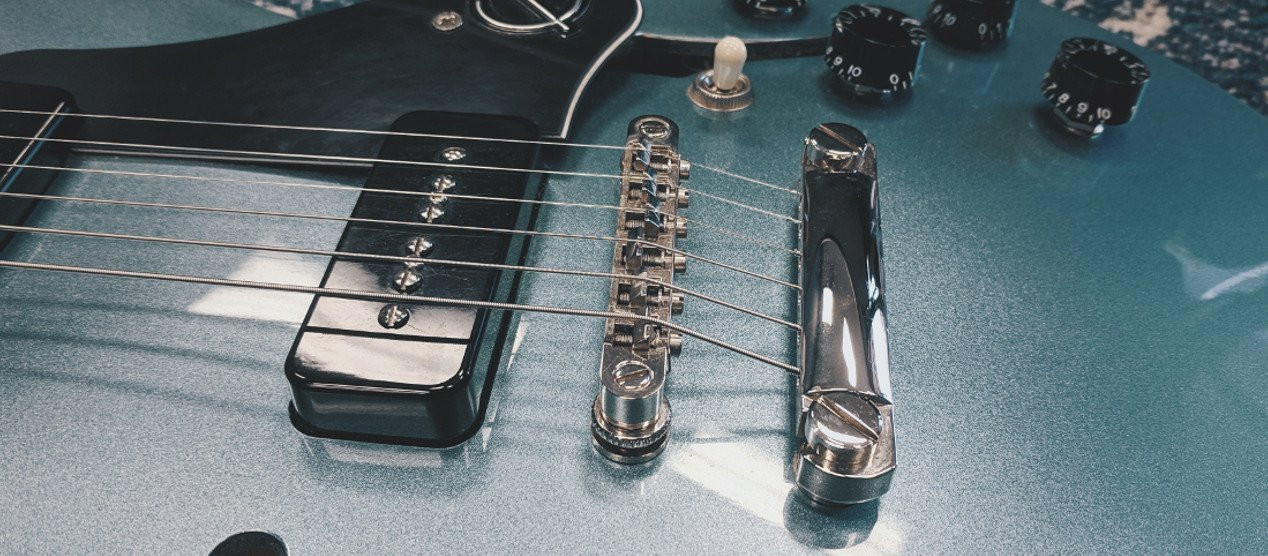 Adjusting Guitar Action at the Bridge
Adjusting Guitar Action at the Bridge
- Types of Bridges
- Fender-Style Bridges:
- Individual Saddles: Each string is adjustable.
- Adjustment Screws: Small screws raise or lower each saddle.
- Gibson-Style Bridges (Tune-O-Matic):
- Overall Height: Adjusts the entire bridge height.
- Thumbwheels: Used to raise or lower the bridge.
- Fender-Style Bridges:
- Tools Needed
- Small Screwdrivers: For Fender-style bridges.
- Allen Wrenches: For some Fender-style bridges and saddle adjustments.
- Thumbwheels: For Gibson-style bridges.
- String Action Gauge: To measure string height accurately.
- Safety Precautions
- Loosen Strings: Slightly loosen strings to reduce tension.
- Small Adjustments: Make small, incremental changes.
- Avoid Over-Adjusting: Can damage the bridge or saddles.
- Steps for Adjustment
- Measure Current String Height:
- Use String Action Gauge: Measure at the 12th fret.
- Record Measurements: Note the current string heights.
- Adjusting Fender-Style Bridges:
- Locate Adjustment Screws: Find the screws on each saddle.
- Raise or Lower Saddles: Use a small screwdriver or Allen wrench.
- Adjust Incrementally: Make small changes and remeasure.
- Adjusting Gibson-Style Bridges (Tune-O-Matic):
- Locate Thumbwheels: Find the thumbwheels on either side of the bridge.
- Raise or Lower Bridge: Turn the thumbwheels to adjust the overall height.
- Adjust Evenly: Ensure both sides are adjusted similarly to maintain proper balance.
- Checking String Height:
- Remeasure: Use the string action gauge to check the new string height.
- Adjust Further: Repeat adjustments as needed.
- Measure Current String Height:
- Maintaining Correct Radius
- Follow Fretboard Radius: Match the curvature of the fretboard.
- Adjust Individual Saddles: On Fender-style bridges, adjust each saddle to match the radius.
- Troubleshooting
- Fret Buzz: Raise the bridge height to eliminate buzz.
- High Action: Lower the bridge height for easier playability.
- When to Seek Professional Help
- Complex Bridges: If you have a complex or unfamiliar bridge system.
- Difficulty Adjusting: If you are unable to achieve the desired string height.
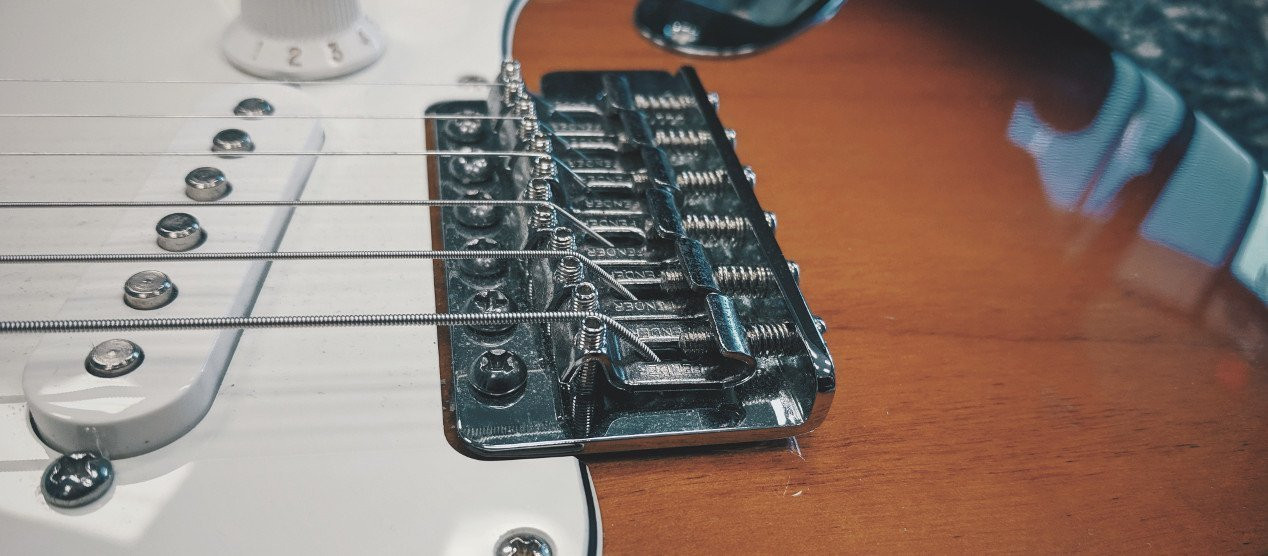 Adjusting Guitar Action on a Fender-Style Bridge
Adjusting Guitar Action on a Fender-Style Bridge
3.4. Step 3: Adjusting Nut Height
Adjusting the nut height ensures correct string height at the first fret. If the nut slots are too low, the strings will buzz; if they are too high, it will be difficult to fret notes.
Adjusting nut height ensures correct string height at the first fret. According to the Roberto Venn School of Luthiery, nut adjustment is vital for playability, published December 2022.
 Adjusting Guitar Action at the Nut
Adjusting Guitar Action at the Nut
- Purpose of Nut Height Adjustment
- Open String Playability: Affects how open strings play.
- First Fret Action: Determines the action at the first fret.
- Tools Needed
- Nut Files: Specialized files for shaping nut slots.
- Feeler Gauges: To measure the gap between the string and first fret.
- Razor Blade or Exacto Knife: For scoring the nut.
- Super Glue and Baking Soda: For filling nut slots that are too low.
- Safety Precautions
- Small Increments: File or adjust in very small increments.
- Protect the Fretboard: Use tape to protect the fretboard from accidental scratches.
- Proper Ventilation: Work in a well-ventilated area when filing.
- Steps for Adjustment
- Assess Current Nut Height:
- Check Open String Buzz: Play each open string and listen for buzzing.
- Measure Clearance: Use feeler gauges to measure the gap between the string and the first fret.
- Lowering Nut Height:
- File Nut Slots: Use nut files to carefully deepen the slots.
- File Evenly: Keep the slots shaped correctly to avoid string binding.
- Check Frequently: Remeasure and check for buzzing after each adjustment.
- Raising Nut Height:
- Shim the Nut: Place a thin shim (e.g., paper or veneer) under the nut.
- Replace the Nut: If the slots are too low, replace the nut entirely.
- Filling Nut Slots (If Too Low):
- Mix Super Glue and Baking Soda: Create a paste with super glue and baking soda.
- Apply to Slot: Carefully apply the paste to the bottom of the slot.
- Let Cure: Allow the mixture to fully harden.
- File to Height: File the hardened paste down to the correct height.
- Assess Current Nut Height:
- Ideal Nut Height
- Minimal Clearance: Just enough clearance to avoid open string buzz.
- Consistent Height: Ensure consistent height across all strings.
- Troubleshooting
- Open String Buzz: Nut slots are too low.
- Difficulty Fretting at First Fret: Nut slots are too high.
- When to Seek Professional Help
- Uncomfortable with Filing: If you are not comfortable filing the nut.
- Expensive Guitar: For valuable or vintage guitars, seek professional help.
- Difficulty Achieving Proper Height: If you cannot achieve the desired nut height.
4. Common Mistakes and How to Avoid Them
When adjusting guitar action, common mistakes include over-adjusting the truss rod, incorrectly filing the nut, and neglecting to measure string height accurately. Avoid these mistakes by making small adjustments, using the right tools, and measuring frequently.
Common mistakes when adjusting guitar action include over-adjusting the truss rod, incorrectly filing the nut, and neglecting to measure string height accurately. According to experts at the Guitar Repairers Association, published January 2023, avoiding these mistakes ensures a successful setup.
- Over-Adjusting the Truss Rod
- Mistake: Turning the truss rod too much at once.
- Consequences: Can cause neck damage, extreme changes in action.
- Solution: Make small adjustments (quarter turns), wait, and reassess.
- Incorrectly Filing the Nut
- Mistake: Filing nut slots too low or at the wrong angle.
- Consequences: Causes open string buzz, intonation issues.
- Solution: Use nut files, file gradually, check frequently.
- Neglecting to Measure String Height Accurately
- Mistake: Not using a string action gauge or precise ruler.
- Consequences: Inconsistent action, uneven playability.
- Solution: Use a string action gauge at the 12th fret for accurate measurements.
- Ignoring Neck Relief
- Mistake: Adjusting string height without considering neck relief.
- Consequences: Can cause fret buzz or high action, regardless of bridge adjustment.
- Solution: Adjust the truss rod first to set proper neck relief.
- Not Loosening Strings Before Adjusting Bridge
- Mistake: Adjusting bridge saddles without loosening strings.
- Consequences: Can damage saddle screws or bridge components.
- Solution: Loosen strings slightly before adjusting saddle height.
- Failing to Maintain Fretboard Radius
- Mistake: Adjusting individual string heights without considering the fretboard radius.
- Consequences: Uneven playability across strings, uncomfortable feel.
- Solution: Match saddle heights to the fretboard radius.
- Using the Wrong Tools
- Mistake: Using improper tools for truss rod, bridge, or nut adjustments.
- Consequences: Can strip screws, damage components.
- Solution: Use the correct size Allen wrenches, screwdrivers, and nut files.
- Forgetting to Check Intonation
- Mistake: Adjusting action without checking intonation afterwards.
- Consequences: Notes will be out of tune up the neck.
- Solution: Check and adjust intonation after setting action.
- Neglecting Fret Condition
- Mistake: Adjusting action on a guitar with uneven frets.
- Consequences: Can cause buzz or dead spots that are impossible to eliminate.
- Solution: Level or dress frets before adjusting action.
- Ignoring Personal Playing Style
- Mistake: Setting action based on general recommendations without considering playing style.
- Consequences: Action may not suit individual needs or preferences.
- Solution: Adjust action to match your playing style.
5. When to Seek Professional Help
If you are uncomfortable with any of these adjustments or if you encounter resistance, it’s best to seek help from a professional luthier. They have the expertise to diagnose and fix complex issues without damaging your guitar.
If you’re uncomfortable with any of these adjustments, seek help from a luthier. According to the Guild of American Luthiers, enlisting a professional avoids guitar damage, published February 2023.
- Truss Rod Resistance
- Problem: The truss rod is difficult to turn or feels stuck.
- Risk: Forcing it can damage the truss rod or neck.
- Solution: Seek a professional to assess and address the issue.
- Complex Bridge Systems
- Problem: Guitars with complex floating bridges (e.g., Floyd Rose) are difficult to adjust.
- Risk: Improper adjustment can affect tuning stability and playability.
- Solution: A luthier can properly balance and set up these bridges.
- Fret Buzz Persists
- Problem: Fret buzz remains despite adjusting action and neck relief.
- Risk: May indicate uneven frets or other underlying issues.
- Solution: A professional can level or dress the frets.
- Intonation Problems
- Problem: Intonation cannot be set correctly after action adjustments.
- Risk: Notes will be out of tune up the neck.
- Solution: A luthier can diagnose and correct intonation problems.
- Unfamiliar with Tools or Procedures
- Problem: Lack of experience with guitar setup tools and procedures.
- Risk: Accidental damage to the guitar.
- Solution: A professional setup ensures adjustments are made correctly.
- Expensive or Vintage Guitars
- Problem: Adjusting valuable or vintage guitars requires special care.
- Risk: Improper adjustments can decrease the guitar’s value.
- Solution: A luthier experienced with vintage instruments can perform the setup.
- Unable to Achieve Desired Results
- Problem: Difficulty achieving the desired action and playability.
- Risk: Frustration and potential damage to the guitar.
- Solution: A professional can fine-tune the setup to meet your preferences.
- Neck Issues
- Problem: Warped or twisted neck.
- Risk: Adjusting the truss rod can worsen the problem.
- Solution: A luthier can assess and repair neck issues.
- Nut Replacement or Repair
- Problem: Damaged or improperly cut nut.
- Risk: Inaccurate string spacing and height.
- Solution: A professional can replace or repair the nut.
- Overall Uncertainty
- Problem: Feeling unsure or uncomfortable about performing adjustments.
- Risk: Potential damage to the instrument.
- Solution: Consulting a luthier provides peace of mind.
6. Maintaining Your Guitar’s Action
Regular maintenance helps keep your guitar’s action consistent. This includes cleaning the fretboard, changing strings regularly, and storing the guitar in a stable environment.
Regular upkeep maintains consistent guitar action. Guitar Player Magazine in May 2023, highlighted the best upkeep practices.
- Regular Cleaning
- Fretboard Cleaning:
- Frequency: Every string change or as needed.
- Procedure: Use a fretboard conditioner to clean and moisturize the wood.
- Benefits: Prevents grime buildup, keeps the wood healthy.
- String Cleaning:
- Frequency: After each playing session.
- Procedure: Wipe strings with a clean cloth.
- Benefits: Removes oil and dirt, prolongs string life.
- Hardware Cleaning:
- Frequency: Periodically.
- Procedure: Clean bridge, tuners, and other hardware with a soft cloth.
- Benefits: Prevents corrosion, maintains functionality.
- Fretboard Cleaning:
- String Changes
- Frequency: Every 1-3 months, depending on playing frequency.
- Benefits: Fresh strings improve tone and playability.
- Procedure: Replace strings one at a time to maintain neck tension.
- Proper Storage
- Stable Environment:
- Temperature: Avoid extreme temperatures.
- Humidity: Maintain consistent humidity levels (45-55%).
- Benefits: Prevents wood from warping or cracking.
- Guitar Case:
- Storage: Store the guitar in a hard case when not in use.
- Benefits: Protects from physical damage and environmental changes.
- Stable Environment:
- Neck Relief Checks
- Frequency: Seasonally or when you notice changes in action.
- Procedure: Use a feeler gauge to measure neck relief.
- Benefits: Ensures proper neck curvature, prevents fret buzz or high action.
- Hardware Adjustments
- Tuner Maintenance:
- Procedure: Tighten loose tuner screws.
- Benefits: Keeps tuners functioning properly.
- Bridge Adjustments:
- Procedure: Check bridge height and intonation periodically.
- Benefits: Maintains optimal string height and tuning accuracy.
- Tuner Maintenance:
- Professional Setups
- Frequency: Every 6-12 months.
- Benefits: A luthier can perform a comprehensive setup, including truss rod adjustment, fret leveling, and intonation correction.
- Seasonal Adjustments
- Humidity Changes: Adjust truss rod as needed to compensate for changes in humidity.
- Winter: Lower humidity can cause the neck to bow backward.
- Summer: Higher humidity can cause the neck to bow forward.
- Nut Maintenance
- Lubrication:
- Procedure: Apply graphite or nut sauce to nut slots.
- Benefits: Reduces friction, prevents string breakage.
- Inspection:
- Procedure: Check nut slots for wear.
- Benefits: Prevents buzzing and intonation issues.
- Lubrication:
7. Action and Intonation: Achieving Perfect Harmony
Achieving perfect harmony between action and intonation is key to a well-playing guitar. Action refers to the height of the strings above the frets, while intonation is the accuracy of pitch as you move up the fretboard. Both must be properly set to ensure the guitar plays in tune and feels comfortable.
7.1. Understanding the Relationship
The relationship between action and intonation is intertwined, affecting overall guitar playability. According to research by

